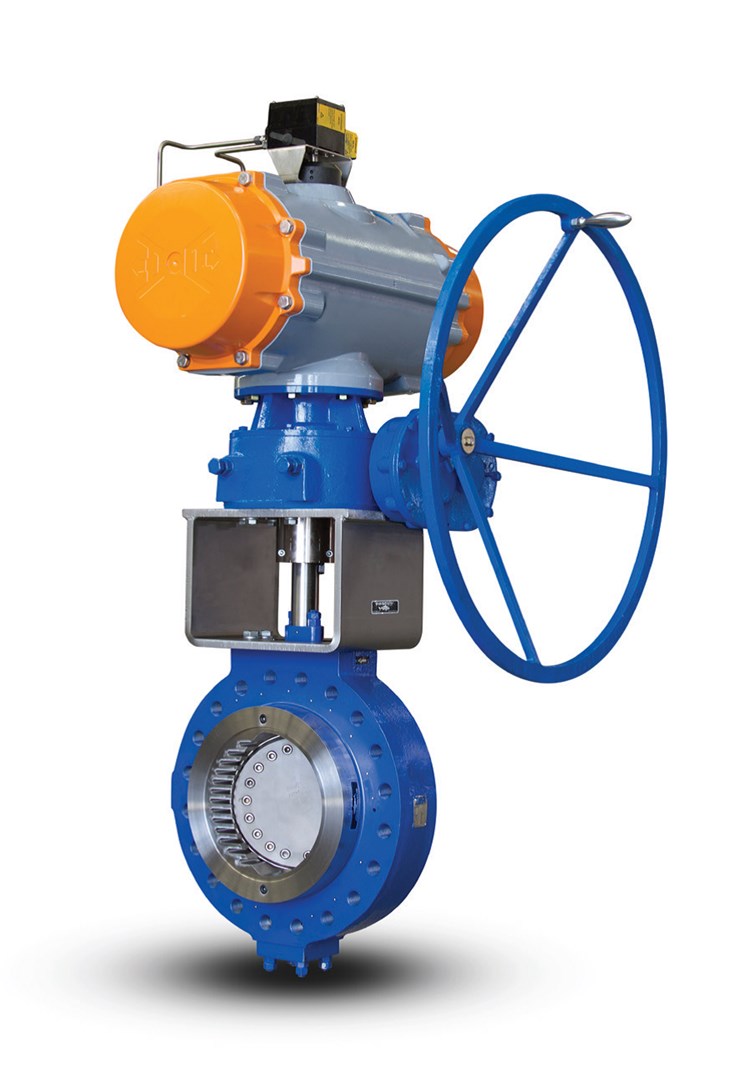These tight shut-off control valves have ‘built-in’ cavitation and noise attenuating properties, and provide an ‘equal percent flow characteristic’, which is known to be a desirable and useful characteristic for excellent flow control.
By Arthur R. Yeary, President – Yeary & Associates & Dave Buse, President – Zwick Valves
In collaboration with the Department of General Engineering at the University of Illinois, in 2005 Yeary & Associates, Inc., sponsored a research project. They were tasked with developing a device that could be added on to butterfly valves, to turn them into control valves for modulating services. This R&D work verified Yeary’s design theories and led the way to further refinements and enhancements under the consultancy of Dr. H.D. Baumann, a prominent control valve expert. Then, after conducting flow tests on a SharktoothTM with a Zwick TOV at the Utah State University Flow Laboratory, in Provo, UT, the first version of Yeary Controls’ custom and proprietary SharktoothTM Sizing Program was created, enabling the company to enter the control valve marketplace.
Exceeding Expectations
The original goal of this technology was to create a simple accessory device that could be added-on to ready-made butterfly valves, to give them the performance characteristics of traditional control valves. This would simultaneously take advantage of the lighter weight, compactness, availability, and lower cost of butterfly valves. When butterfly valves are required to throttle at lower angles, just a small amount of disc movement causes a large increase in flow; and at the higher angles of opening, a large amount of disc movement is needed to cause a small change in flow. Another shortcoming of butterfly valves in throttling services is that a rapid torque reversal can occur due to the sudden pressure change that occurs on the downstream surface of the disc at about 60 to 75 Degrees of disc angle. To address these issues, Zwick Valve, with the help of Yeary Controls, added Yeary’s proprietary ‘Sharktooth Control Cartridges’ to their Triple Eccentric Butterfly Valves.
Since their introduction in 2005, valves with control cartridges have proven to not only correct the poor flow characteristics that are typical of butterfly valves, but has also significantly reduced the damaging effects of cavitation and noise, which is a common problem in industrial valve applications. These control valves are now being specified for severe service applications, such as salt cavern brine injection and withdrawal, deaerator steam control, natural gas production slug catcher systems, and pump bypass services.
A Versatile Technology
For most services, a ‘wafer style’ control cartridge is simply attached to the outlet side of off-the-shelf butterfly valves, and the assembly is then held in place by sandwiching it between two pipe flanges. Although wafer lug bodied TOV’s are employed for about 75% of all applications, double flanged, and even weld-end versions, have been produced. For instance, one configuration that is gaining in popularity and importance is an ‘extended length’ control cartridge. When this is added-on to the butterfly valve, it allows for matching the take-out end-to-end dimensions of other control valves, such as the ISA S75.04 end-to-end dimension, common to most rotary segmented ball and Vnotch control valves.
For applications that exceed the noise and cavitation attenuating abilities of its standard control packages, custom engineered diffuser plates can be provided. These extend the cavitation and noise attenuation abilities of the standard technology, to provide a price competitive alternative to other more expensive severe-service control. This could save thousands of dollars on the initial purchase price of the valves, as well as future maintenance costs.
Technical Advantages
1. Flow Centering: A major benefit of the technology is how it centers the discharging flow into the middle of the pipe. All other types of rotary valves direct the flow against the valve body wall, or onto the side wall of the adjacent outlet pipe. This causes wear and damage to either the valve body, or the outlet pipe. By centering the discharging fluid as it leaves the life of the valve and the downstream pipe will be significantly extended when dealing with cavitation, or the throttling jets of fluids and vapors.
2. Excellent Process Control in Large Sizes: The range of sizes for these valves allows them to be used in situations where an end user might otherwise be forced to use a regular butterfly valve for control due to cost.
3. Cavitating Liquid Applications: In general, a valve with this technology can handle from 2-3 times the pressure drop of a typical rotary style control valve before experiencing a cavitation problem.
4. Absolute Zero Leakage: As the TOV’s provide true zero leakage, and a long cycle life due to their frictionless seating and unseating force requirements, when one is paired with the SharktoothTM control cartridge, the resultant control valve will provide bubble tight shut-off. Additionally, there is smooth operation and, most importantly, great process control. These features are particularly desirable in applications such as Steam Turbine Bypass where control valve leakage is unacceptable because the valve needs to stay closed during most of its service life.
5. Flow Control for Contaminated Fluid Streams: As these control cartridges are able to pass high levels of dirt and debris, they are being used in many steel mill water flow control applications where they need large valves capable of handling strong cavitation, and dirty water without plugging.
Control valves, which are oftentimes called ‘The Final Control Element’, are carefully chosen based upon their performance reputations in the field. It is therefore beneficial to have a valve paired with a technology that can reliably provide excellent flow control in a wide cross-section of industries.




